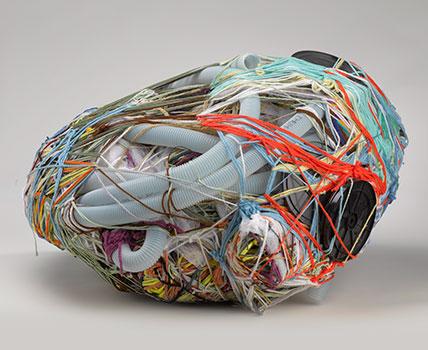
Judith Scott, Untitled 2004. Fiber and found objects. 18 x 24 x 30.
The Smith-Nederpelt Collection. Copyright Creative Growth Art Center.
Photo by Sarah DeSantis, Brooklyn Museum
This image shows a sculpture created by wrapping yarn tightly around a collection of found objects, including light blue plastic tubing, black plastic objects that may be disposable coffee cup lids, and white nylon mesh. The most prominent yarn colors are orange, blue, yellow and white.
In this course, students engage with recent work in critical disability studies across a range of humanistic disciplines, including literary studies, visual studies, history, and philosophy. Drawing on these varied disciplinary perspectives, we explore how disability theory and engaged community practice inform and shape one another. Along the way, we discuss the historical and theoretical development of the ideas of normalcy and disability; questions around ethical engagement and inclusive design; the growth of disability arts and culture; and the relationship between disability, access, and exhibition practices. The course includes a semester-long collaborative art project in partnership with the Center for Creative Works (CCW), a studio and teaching space in Wynnewood, PA, for artists with intellectual and developmental disabilities. In non-pandemic years, this project involves weekly sessions, alternately at Haverford and CCW, and culminates in an end-of-semester art exhibition at Haverford. During the pandemic, we'll get creative about collaborating via Zoom.
